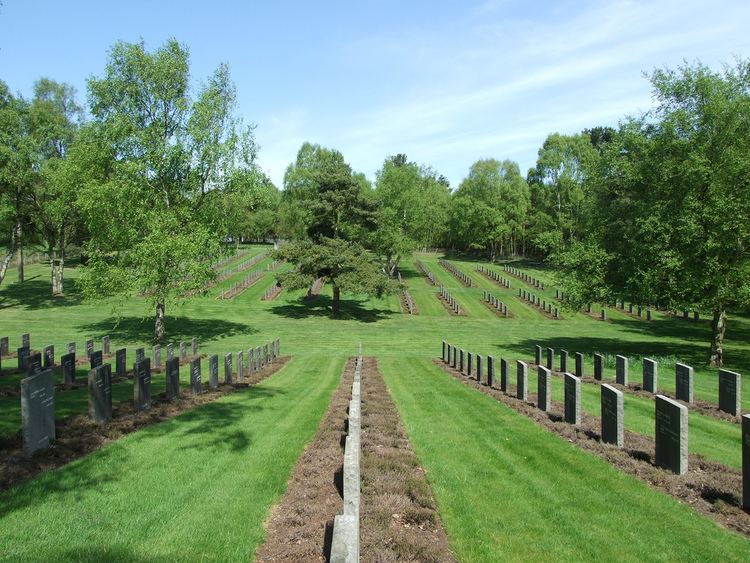Total burials 4,929 | ||
 | ||
Established 1956 (consecration cemetery) Address Brocton, Cannock WS12 4PS, UK Hours Open today · 8AM–4PMWednesday8AM–4PMThursday8AM–4PMFriday8AM–4PMSaturday11AM–4PMSunday11AM–4PMMonday8AM–4PMTuesday8AM–4PM Burials Ernst Busch, Maximilian von Herff, Emil Bitsch, Alois Stoeckl, Walter Rubensdörffer | ||
The Cannock Chase German Military Cemetery (grid reference SJ984157) is on Cannock Chase, Staffordshire, England.
Contents
History
On 16 October 1959, the governments of the United Kingdom and the Federal Republic of Germany made an agreement about the future care of the remains of German military personnel and German civilian internees of both World Wars who at the time were interred in various cemeteries not already maintained by the Commonwealth War Graves Commission. It was agreed that the remains would be transferred to a single central cemetery established on Cannock Chase for this purpose.
The German War Graves Commission (Volksbund Deutsche Kriegsgräberfürsorge or "VDK") made the necessary arrangements and the inauguration and dedication of this cemetery - which is maintained under the inter-government agreement by the Commonwealth War Graves Commission - took place in June 1967. It contains nearly 5,000 German and Austrian graves. A number of World War II Ukrainian volunteers captured when in German service are also buried here.
Layout of the Cemetery
The entrance building contains toilets for visitors and a visiting room where the Cemetery Register is available on request. A plan of the plots within the cemetery is also on display. From here a small courtyard with a covered passage forms the connection to the Hall of Honour, which has at its centre, resting on a large block of stone, a bronze sculpture of a fallen warrior, by the eminent German sculptor, Professor Hans Wimmer. Open passageways give a clear view of two terraces. On the west-facing terrace there is a granite monument to the crews of the four airships (SL 11, L32, L31, L48) shot down in World War I and who lie buried here in a tomb in separate sarcophagi.
The other terrace forms a link between the Hall of Honour and the cemetery. The graves of the dead of the First and Second World War are generally separated and lie on either side of the gentle slopes of the cemetery with a valley between them. The burials are marked by headstones from Belgian Petit Granit and are usually inscribed for two individuals on the front and on the back.
Notable graves
Notable people include:
German war graves elsewhere in UK
According to the Volksbund Deutsche Kriegsgräberfürsorge, just over 1000 German World War II casualties are still buried elsewhere in the UK, including 111 at Saint Peter Port (Fort George), Guernsey, and others at Brookwood Cemetery, Surrey. The remainder are interred in Commonwealth War Graves Commission-administered plots all over the UK, often near where their bodies were found or where they died. For example, three Luftwaffe bomber crew, whose Dornier ditched in the sea off Kingsdown, Kent in 1940, were buried in the military section of Hamilton Road Cemetery, Deal, Kent, less than 2 miles from the crash.
In the same locality as this cemetery, the Commonwealth Cannock Chase War Cemetery contains 286 German war graves, primarily of those who died in a local prisoner-of-war camp and hospital in World War I but also including graves of 58 Germans who had been reinterred here in 1963.
A proposal was made to rebury in this cemetery former Imperial German Navy officer Carl Hans Lody (shot for espionage at the Tower of London in 1914) in the 1960s. The VDK asked if it would be possible to disinter Lody's body from East London Cemetery in Plaistow and move it to Cannock Chase. By that time, the plot had been reused for further common graves, buried above Lody's body. The VDK was told that it would not be possible to disinter the other bodies without the permission of the relatives, which would have been an almost impossible task where common graves were concerned. The proposal was abandoned and Lody's body remains at Plaistow.
